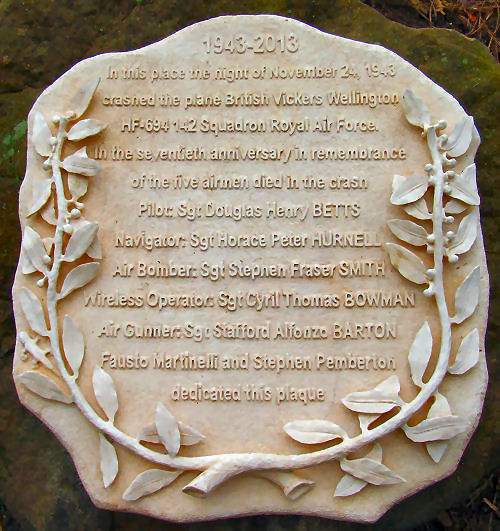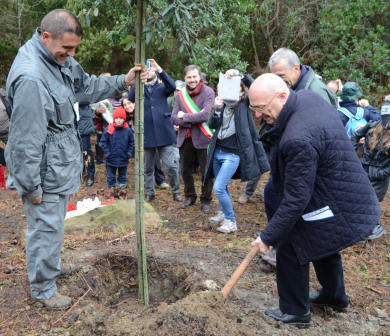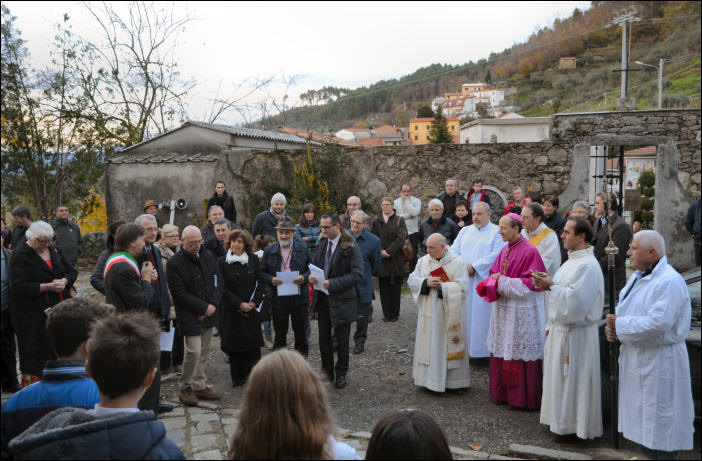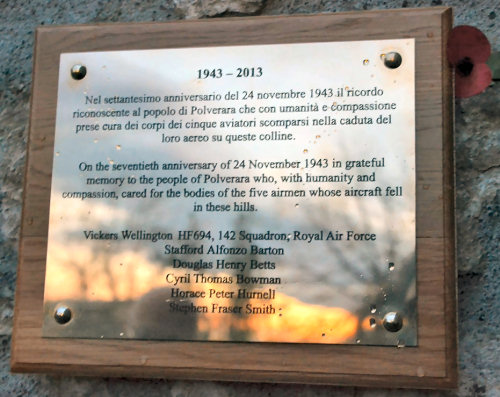70th Anniversary in 2013
An Email from Italy
The story starts earlier in the year when I had re-written much of this web site and still wanted to find the site of the crash of my uncle Stephen's aircraft. Accordingly, I decided in March to write to Franco Cossani who I had chanced to meet during my visit to Italy in 1997. As a child in 1943 he had seen the crash site. When I met him he had been kind enough to arrange for his son Giuseppe to drive me into the woods by tractor to try to find the site. Our combined lack of knowledge of the area meant we were unsuccessful. My letter initially seemed to produce no result and I had almost given up when I received an email at the end of May. It was from Fausto Martinelli and he explained that he was Franco's cousin. He promised that he would try to help me in my quest to identify the crash site. Fausto and I then exchanged many emails and significantly one in which he asked for a copy of the letter written by Eraldo Manfroni in 1945, in which the location of the crash site was described in some detail.
Planning
Soon came the news that Fausto had taken Franco to the location described in Eraldo Manfroni's letter. The combination of the letter, Franco’s memory and Fausto’s intimate knowledge of the terrain enabled them to find the exact location even though it was now covered with trees and undergrowth. I was thrilled and my initial proposal was to visit Polverara in September when the weather would be reasonably assured. It was Fausto, however, who pointed out that 2013 was significant being the 70th anniversary of the crash and that the weekend of 23rd and 24th November would be the most appropriate. By the end of July Fausto had sent me details of the survey he had carried out together with a Google Earth image with the site details superimposed. To my surprise, the aircraft hit the ground whilst flying in a southerly direction. Fausto arranged to have the crash site cleared and also to have the woodland track, which led from the village, improved.

Little by little and through a series of emails it was agreed that with my wife Margaret and I would visit Polverara in November. There would be two ceremonies: the first on Saturday 23rd to commemorate the deaths of the five airmen at the crash site, and a second on Sunday 24th to recognise the kind actions of the villagers. Fausto would provide a stone plaque at the crash site at which I would lay a poppy wreath. I would provide a brass plaque which would be located somewhere in the village. I soon discovered that Fausto was both resourceful and influential. He was also true to his word. Despite our language difficulties we gradually developed and agreed the wording for the two plaques. At Fausto's insistence it was agreed that we would stay as his guests in his house at Polverara.
Next came the news that Fausto had sought and obtained agreement from the local priest that my brass plaque could be fixed to the wall of the church of St.Nicolo in Polverara village. The priest would be present at its dedication. I was delighted and arranged for its production. Fausto would provide the plaque at Venturello. He then gave me the news that the two ceremonies would be in the presence of the Mayor of Ricco del Golfo. A further development was that the ceremony on the Sunday would be in the afternoon because His Most Reverend Eminence Bishop Luigi Ernesto Palletti had agreed to attend.
What had begun as a simple intention to visit the crash site and perhaps provide a memorial had developed into two ceremonies, both of significant proportions. I remained deeply concerned, however, about the weather, which 70 years before had cost the lives of so many airmen, and could impair the weekend's arrangements.
Friday 16th November
With just a week before the memorial ceremonies, I received an incredible email from Elisabetta Manfroni. She is the daughter of Eraldo Manfroni who had sent the letter to my grandparents in 1945. It transpired that Fausto had arranged for details of the ceremonies to be published in a newspaper, La Nazione. Living in Florence, Elisabetta had read the article and after some difficulty had managed to contact Fausto. She had then seen this web site and sent an email to me. This news was a revelation. Whilst she was unable to attend the ceremony on the 23rd, she and her family would come to Polverara on the 24th and she would bring the documents that her father had prepared so very many years before. Yet again, Fausto’s influence had produced an amazing effect. The weather in Liguria at this time was terrible with persistent heavy rainfall.
Friday 22nd November
At last, the day of our journey arrived and the forecast suggested a potential break in the weather. Margaret and I traveled to London Gatwick on Thursday 21st November. The next day we flew to Pisa arriving just before noon. The rain had stopped and the hills to the east of Pisa were clothed in snow. Having collected a hire car we then drove to Polverara through the coastal town of La Spezia.
Fausto was awaiting our arrival and introduced us to his wife Fiorella, to his personal assistant Daniela, and to many of his relatives and friends. It was immediately clear how thoughtful Fausto was. He was determined that someone would be available at all times to translate between Italian and English. Daniela would interpret until the following morning when she needed to travel to Rome to attend to her father. She would be replaced by Fausto's son-in-law, Riccardo, who would be arriving during the night. Also due to arrive from Switzerland the next day would be Fausto’s friend, Luca, who would share this task. We were shown to the apartment that Fausto and Fiorella had provided for us. It proved to be extremely comfortable and warm, with panoramic views down to La Spezia and up towards Venturello. Later, when we had been refreshed, I accompanied Fausto and his two cousins Fabio and Massimiliano to the church where we fixed my plaque in its agreed position on the wall of the church. These two seemed to make all sorts of things “just happen” throughout the weekend. I took the opportunity to visit the cemetery where the crew had once been buried and it transpired that we walked on the very path over which the five coffins had been carried in 1943. That evening we were to be treated to an extensive meal provided by Fiorella and the arrangements for the next day were explained.
Saturday 23rd November
The day started dull but dry. As the scheduled time for the ceremony approached we started to assemble ready for the walk up to the crash site. Little by little more and more people arrived. I was introduced to the Mayor Sig. Carlo Mazza who was accompanied by Franco Isetta who is the standard bearer for the municipality of La Spezia. Fausto was concerned that the recent days of heavy rain made the woodland track difficult. Ever resourceful, he had arranged for several four-wheel drive vehicles to transport us.
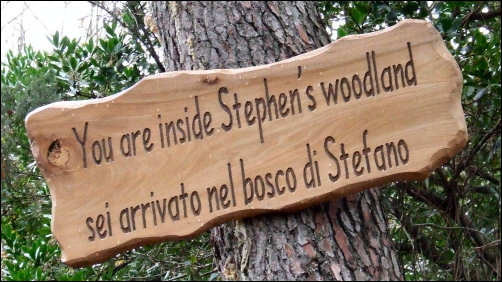
A First Surprise !
It took just minutes to drive from the top of the village up to the crash site at Venturello. My first surprise was a sign indicating “Stephen’s Woodland” which Fausto had fixed to a tree at the entrance to the clearing. We had a few minutes before proceedings commenced which allowed me to walk around the sloping area that Fausto had cleared. He had thoughtfully saved five bushes of Arbutus Unedo (strawberry tree): one for each member of the crew. The bushes bear white flowers in spring and red berries in the autumn. Ahead of me was the plaque which at this time was covered with a white cloth. Beneath it was a group of red and white cyclamen plants set in a wooden trough. I was shown a tree that was to be planted as part of the ceremony. I then walked to the edge of the site realising that we were on the top of a ridge. To the north is a deep valley with majestic snow-capped hills beyond. To the south, though not visible through the trees, is the coastal town of La Spezia. The immediate area comprises hills covered with dense woodland. The clearing was soon filling with people of all ages. Fausto’s extended family and friends were present, many villagers, and even a TV crew.
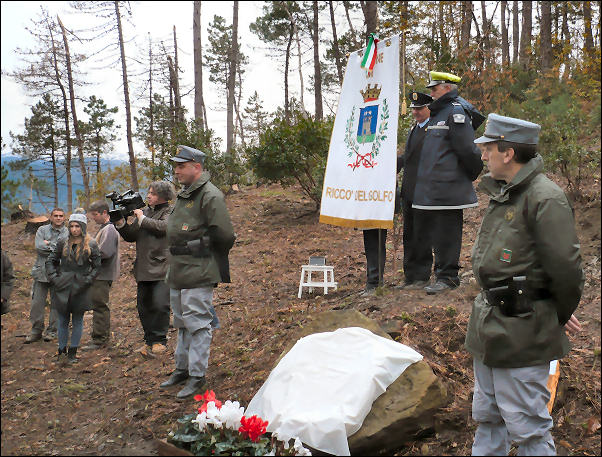 |
Ceremony about to start: To the left are Fausto's cousins Massimiliano and Fabio with the TV presenter and cameraman. Two members of the Forestry Corp stand either side of the plaque. Two local policemen flank Franco Isetta and the flag of Ricco del Golfo |
I sensed that the time had come and took my place next to Fausto. Two members of the Forestry Corp took up their positions as either side of the plaque. To one side was the flag of Ricco del Golfo held by Franco Isetta who was flanked by two local policemen. All went quiet as Fausto and I stepped forward and gently removed the cover from the stone plaque. It is splendid. Fausto had arranged for it to be carved from an almost white stone. It is fixed to an existing stone naturally located in the middle of the clearing. The inscription is in English (a translation into Italian had been separately provided) and surrounded with leaves carved in high relief. The sculptor’s identity, in the form of a gecko, is clearly evident on the lower left side.
 |
|
Fausto returned to his place and I was handed the poppy wreath. As I bent forward to lay it, recordings of the "Last Post" and the "Silenzio Militare Italiano" were played. As I stood with bowed head I realised that at last I had commemorated the death of my Uncle Stephen and his four comrades.
|
Three speeches then followed, the first by the Mayor Sig. Carlo Mazza, the second by my host Fausto Martinelli, and lastly in my speech I briefly explained how Fausto and Franco had found the crash site. I described the significance of the poppy wreath, and thanked everyone for their interest and their attendance. All the speeches were translated. The ceremony caught the attention of the local media. This image also shows just some of the villagers, of all generations, who made the trip up into the woods
|
|
Fausto’s agenda had not prepared us for the next event. The mayor stepped forward and presented both Fausto and myself with boxed commemorative plaques from the municipality. It was truly an honour and I will treasure his gift.
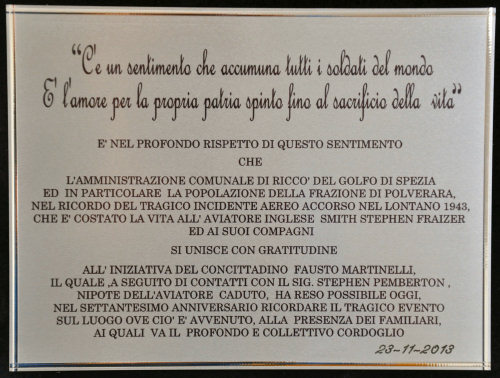 |
"There is a universal feeling that all soldiers of the world have love for their homeland, even to the sacrifice of life" In deep respect of this feeling that the administration of Ricco del Golfo of La Spezia and in particular the population of the village of Polverara remember the tragic aircraft accident back in 1943 that cost the life of the English airman Stephen Fraser Smith and his companions and join with gratitude for the endeavours of fellow citizen Fausto Martinelli who as a result of contact with Mr. Stephen Pemberton, nephew of the dead airman, who has made possible today’s seventieth anniversary which remembers the tragic event in the place where this occurred, in the presence of the family, to whom go deep and collective condolences 23-11-2013 |
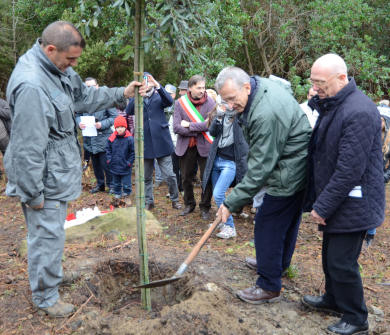 |
Fausto then beckoned me to help plant the tree which appropriately being an olive symbolises peace. Massimiliano held the trunk while I added some soil. Fausto added some more before leaving the “experts” Fabio and Massimiliano to complete the task. |
|
|
Just when everyone thought the ceremony complete, a helicopter of the Forestry Corp over-flew the clearing in salute. Fausto had organised a truly memorable occasion. It was rightly reported in the newspapers as also being "very emotional." |
|
I returned to where I had laid my camera and hat. As I picked them up I spotted something man-made. Almost covered with leaves and earth was a small fragment of Bakelite. Clearly a material widely used during the war, could this be a small relic of Wellington Bomber HF694? Before leaving Venturello I was to be interviewed by the TV crew. It was apparent that the event had attracted a great deal of media attention. It was with some regret that we left the clearing and made our way back to the village.
Lunch was provided by the ever generous Fausto at a local trattoria, and in the evening Margaret and I were honoured to be included in a family birthday celebration.
Sunday 24th November
Again the day started dry and a little brighter. We had little to do until Elisabetta Manfroni arrived at about midday. Fausto was visibly relieved when Elisabetta and her family arrived after their car journey from Florence.
 |
Everyone moved into Fiorella’s dining room where various documents were laid out, examined and compared. It was clear that Elisabetta possessed documents which would further explain the events of 70 years ago. |
Again, Fausto had arranged for a delicious lunch in another trattoria giving us yet more opportunity to try the food of Liguria.
At the appointed hour Fausto drove us to the church yard where the afternoon’s ceremony would take place. By the time the Bishop arrived, a significant audience had assembled. Not only were there people intent on witnessing our ceremony but also the families of eight children who were due to be confirmed by the Bishop.
|
There were four speeches. The first one from Mayor Sig. Carlo Mazza followed by that of Fausto Martinelli.
The gate behind leads into the cemetery |
|
 |
There was just enough time for Fausto and I to step forward and unveil the brass plaque behind which I tucked the poppy I had worn during the year’s remembrance period. His Emininence the Bishop then blessed the plaque and all those present before he and the priests moved into the church for the Communion service. Our ceremony and my personal quest was complete.
Fausto, Elisabette, Stephen and Mayor Carlo Mazza |
|
Nel settantesimo anniversario del 24 novembre 1943 in ringraziamento
ricordo On the seventieth anniversary of 24 November 1943 in grateful Vickers Wellington HF694, 142 Squadron, Royal Air Force |
|
Monday 25th November
The day dawned cold but bright and cloudless. I decided that I would return to Venturello. Fausto asked if he might accompany me and we set off together through the woods.
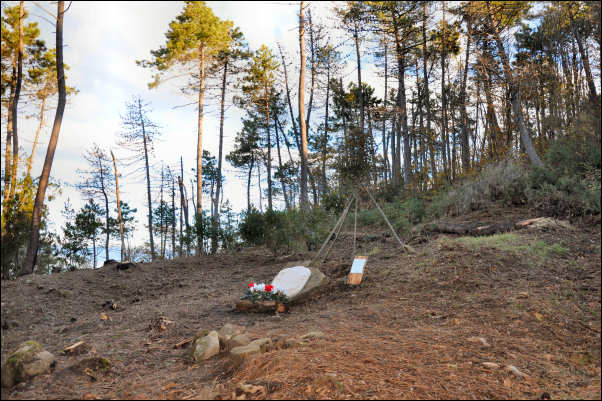 |
The clearing at Venturello was now silent except for the breeze and the birds Fausto had recovered the wreath for safe keeping and the olive tree had been staked.
Our dead are never dead to us, We will remember them |
I stood for some time at the memorial plaque before Fausto asked if I would like to walk on up to Monte Croce. This was mentioned in Eraldo Manfroni’s letter and is the highest point on the ridge.
|
Once there had been a church on the site which had three doors, one for each of the local villages. It had also been the location of a German gun emplacement during the war. The walk did not take long and the views from Monte Croce both to the south down to La Spezia and the mountains to the north were truly magnificent. This view is down the coast towards Livorno |
 |
Nearly back at Torre, I suggested that I would like to follow the route taken by the original forest track. Fausto understood and agreed. Coming to an ancient wall he indicated a stone. It was clear that he wanted me to know that it had witnessed the passage of the bodies of the five airmen.
Soon it was time to say thank you and farewell to our kind hosts Fausto and Fiorella. As we drove down through the village, we returned to the church. In bright sunshine I could look once more at the cemetery where once the five airmen had been buried. I briefly stepped inside the church which is just as beautiful as I remember it. We drove away content. I had achieved my ambition that permanent monuments to my uncle Stephen and his fellow crew members had been established. And, perhaps, another generation now appreciates the sacrifice made by its forebears and understands the horror and futility of war.
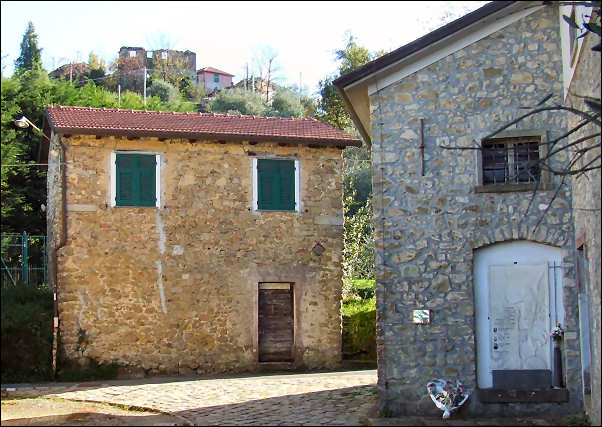 |
In front was the building where Eraldo Manfroni had taught the village children. On the hillside was the ruin of his former home. The plaque I had unveiled shone brightly, but soon to tarnish and has taken its place next to the village war memorials. |
|
Seventy years ago the activities of the local teacher, Eraldo Manfroni, had given so much comfort to the families of the five dead airmen. Now the actions of my new and valued friend Fausto had made possible the comprehensive and fitting memorials. Vi ringrazio molto, Fausto |
 |
Postscript January 2017: It was with great sadness that we learnt that Fausto had died during the summer of 2016. I knew him for only the four days when we attended the commemoration in November 2013. Fausto and his wife Fiorella went to great lengths to ensure our welcome and our comfort. In organising so much of the events, it was clear that he was generous, determined, efficient and influential. He often addressed me as his friend and I am honoured to have known him and consider him to have been my friend.
Che Dio vi benedica e vi custodisca, Fausto
(May God bless you and keep you, Fausto)
